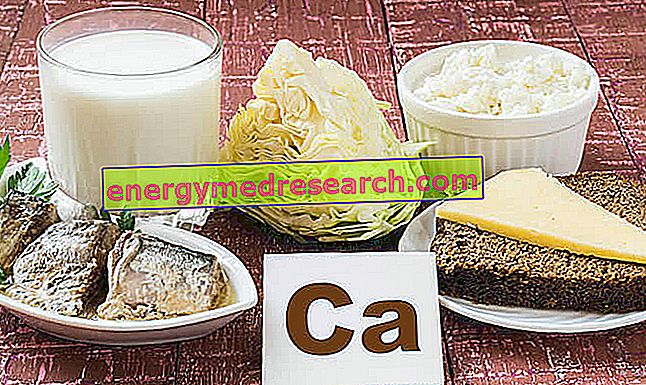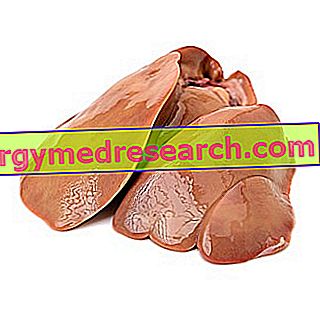Watch the video
X Watch the video on youtubeFootball
Calcium is the most abundant mineral in the human body.
Like phosphorus, most calcium resides in bones, in which it also plays a structural and reserve role for the body.
Only 1% of body calcium is dissolved in the soft tissues (inside the cells, in the matrices, in the blood, etc.) and about half is the functionally active portion (nerve conduction, muscle contraction, enzymatic activation, etc.).

The calcium requirement varies according to sex, age, particular physiological conditions (gestation, breastfeeding) and the possible presence of specific diseases.
Being a mineral necessary for the formation and maintenance of the skeleton, the calcium requirement is greater (in a relative sense in the infant and absolute in the older age groups) during development and in the period in which bone metabolism becomes precarious.
Using a very large reserve (skeleton), calcium deficiency rarely manifests itself with acute and early symptoms (except for infants); on the other hand, however, the protracted deficit, as well as the low concentration of vitamin D (implicated in the metabolism of the mineral), can induce various osteopenic bone complications (rickets, osteomalacia and osteoporosis).
Excess calcium with the diet is almost impossible and, in the eventuality, it can "only" alter the absorption of other minerals; if associated with the excess drug of vitamin D, the excess of calcium can give rise to various renal problems.
Football in Food Groups
Starting from the assumption that, in Italy, the average calcium intake is insufficient (820mg / day), we try to better understand what are the food sources that should contribute to gaining the recommended ration.
In the Bel Paese diet, calcium is provided for as much as 65% by the II fundamental group of foods, or milk and derivatives.
In second place we find the vegetables (VI and VII group - but not the fruit) that bring about 12%. Cereals follow (group III - but not potatoes) which contribute 8.5%. Meats and Fish (The group - but not the eggs) provide only 6.5% of the total.
In this ranking there are still several foods that, if taken individually, do not have a statistical relevance; on the other hand, all together cover the remaining 8%. These include legumes (IV group), seasoning fats (V group) and fruit (part of the VI and VII group). To be sure, the latter together has an average calcium concentration of almost nothing; just think that the butter, or the condiment that contains the most, barely reaches 25g / 100g. On the contrary, some legumes and relative flours are frankly rich; however, their average consumption in the Italian diet has decreased to the point of making them an almost obsolete food.
There is also another category of food unrelated to the previous classification and which, on the other hand, provides good levels of calcium; these are the oil seeds, or dried fruit (nuts, hazelnuts, almonds, pecans, macadamia, peanuts, pistachios, pine nuts, Brazilian nuts, etc.) and other smaller seeds (flax, poppy, sesame, beet, psyllium etc). Also in this case, the average consumption in the Italian diet is rather low, which is why they play a marginal role.
Unlike legumes - of which research institutions suggest increasing portions - nuts cannot be eaten in equally generous doses; this recommendation is due to the very high lipid content that, despite being distinguished by the excellent quality of fatty acids (basically polyunsaturated and monounsaturated), shows a very high caloric potential.
Foods with More Calcium
The function of this chapter is not to mention the foods that, in an absolute sense, provide the greatest amount of calcium; rather, it aims to highlight what are the richest foods of the mineral in each of the groups already mentioned.
Milk and Derivatives (Group II)
Particularly noteworthy are the values of the cheeses, especially the seasoned ones: Latteria 1057mg / 100g, Gruyere 1123mg / 100g, Emmenthal 1145mg / 100g, Parmesan 1159mg / 100g, Pecorino Siciliano 1162mg / 100g and Grana 1169mg / 100g.
Speaking of fresh foods, the calcium content in milk and yogurt is around 120-125mg / 100g.
Vegetables (VI and VII group)
Particularly noteworthy are the values of aromatic herbs, such as sage, rosemary, basil, mint etc. However, these are products whose portion is so moderate that it is not nutritionally relevant. The others are: Radicchio Verde 115mg / 100g, Agretti 131mg / 100g, Chicory 150mg / 100g, Turnip Leaves 169mg / 100g and Spinach 170mg / 100g.
Legumes (IV group): considering those in dehydrated form, we mention: Ceci 142mg / 100g, Beans 135mg / 100g and Soy 257mg / 100g.
Cereals and Derivatives (Group III)
Cookies for Children 104mg / 100g, Wheat Bran 110mg / 100g, Buckwheat 110mg / 100g, Muesli 110mg / 100g, Breadcrumbs 110mg / 100g and Milk Sandwiches 130mg / 100g.
Fish and Meat Products (Group I)
Particularly noteworthy are the fishery products, in particular the molluscs or the fish that the bone is also consumed: Lattarini 888mg / 100g, Caviar 276mg / 100g, Oyster 186mg / 100g, Anchovy 148mg / 100g, Squid 144mg / 100g, Octopus 144mg / 100g, Suro 125mg / 100g and Gambero 110mg / 100g.
Preserved, fresh meat and offal have exponentially lower calcium concentrations (around 40-20mg / 100g, ) but their consumption frequency is much higher than in fishery products.
Antinutritional elements
Sometimes, eating foods rich in calcium is not enough; it is also good practice to consider other factors that are generally ignored. One of these is the potential for absorption.
The intestinal absorption of calcium is mainly influenced by the following factors:
- Presence of amino acids
- pH inside the intestinal lumen, guaranteed by gastric function (Hcl)
- Presence of anti-nutritional elements.
Leaving aside the first two points, we will now talk about the so-called anti-nutritional elements.
These derive mainly from foods of vegetable origin and are of various kinds; they negatively affect the absorption of certain nutrients in two different ways: by directly binding the molecule or ion (preventing its absorption), or inactivating the digestive enzymes.
As far as football is concerned, the anti-nutritional element par excellence is oxalic acid / oxalate; this organic acid binds the calcium ions generating the calcium oxalate and preventing the capture of the mineral by the intestine. Moreover, if absorbed before its association, the oxalic acid enters the circulation and can bind to calcium at a later time; this explains the tendency to kidney stones.
Oxalates are mainly found in spinach, parsnips, rhubarb (and many other vegetables), whole grains (in bran), tea, cocoa and certain legumes such as soy.
It is therefore advisable to eliminate the soaking water (referred to dry legumes) and to exploit total cooking; if this is not possible, it is advisable to take these foods away from the main meals.
Water Football
As we have seen, the main source of calcium is made up of foods while (depending on the source of research) the water plays a secondary or even zero role; it is not yet completely clear whether the calcium contained in the drinks is absorbable or not.
Many argue that the chemical reactions between calcium and other water ions (carbonate, hydrogen, magnesium, sulfur, nitrogen, chlorine, etc.) make the mineral unavailable, negating intestinal absorption; in other words, the calcium salts that are spontaneously generated in the water could cause it to be expelled with the faeces.
Moreover, if it is true that some waters boast a concentration of the mineral that reaches 400mg / l, it is equally true that many others are almost totally deprived of it.
Reach the Soccer Ration
To be sure to easily satisfy the calcium requirement, it is necessary to respect as much as possible the portions and frequencies of consumption of the various foods.
Milk and yogurt, for those who are not lactose intolerant, must be food for daily consumption. In all, a cup of milk (150-250ml) and one or two jars of yogurt (120g) natural every day could be the most correct solution.
For lactose intolerant, the dietetic food market offers various fortified vegetable solutions (ie added with missing nutrients).
The same is not true for aged cheeses; these should constitute an evening dish (main course) of about 50-90g one or at most twice a week. On the other hand, one or two teaspoons of grated cheese (5-10g) on the first courses have no contraindications.
Even the meat and fishery products are mainly used in the composition of evening dishes, about 4-5 times a week, in portions of 150-250g.
Vegetables should be food for daily consumption, at least twice a day and in portions of 100-300g (depending on the type).
Cereals and derivatives should be used as a base for first courses, for snacks, for food for breakfast and for accompanying food. Portions are very variable.
As far as legumes are concerned, instead, it would be a good idea to consume them at least two or three times a week, replacing / supplementing the first courses with cereals or to accompany less caloric dishes.
As anticipated, oilseeds can be useful in guaranteeing the share of calcium (in particular almonds). The portion should be a few grams (about 10g) and, if you like to increase it, it is better to keep in mind that every 10g of oilseeds it is necessary to reduce the dressing fats by about a teaspoon (5g).



